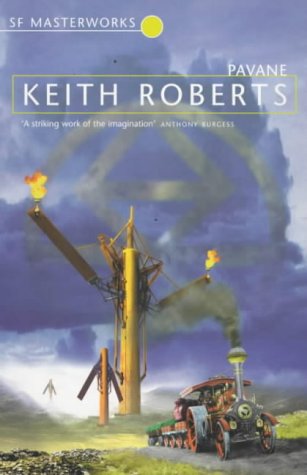Mining the Genre Asteroid: PAVANE by Keith Roberts

In 1588, Queen Elizabeth, the Faerie Queen, was assassinated. Without her leadership, and with the rise of English Catholics in response, Spain found it easy to occupy England and bring her back to Mother Church. And with England so tamed, the throne of St. Peter took back the entirety of Europe from Protestantism, and then the world. James Cook had the flag of the Pope, not of England, when he landed in Australia. Spain controls the entirety of the New World. The Church keeps a tight control over technology and culture, as well, shutting down obvious lines of development. Semaphone wires, coal fired trains, and a residual feudal culture dominate England and the world. Black powder guns are still state-of-the-art weapons. Such tight control has its costs, and its victims. Now, though, almost four centuries after Elizabeth’s death, in a small region of England, the dominance of the Church in matters temporal and spiritual — in England and the world — may finally begin to loosen. All of this can be found in Keith Roberts’ alternate history classic, Pavane.
My Superpower: Michael Panush

My Superpower is a regular guest column on the Skiffy and Fanty blog where authors and creators tell us about one weird skill, neat trick, highly specialized cybernetic upgrade, or other superpower they have, and how it helped (or hindered!) their creative process as they built their project. Today we welcome Michael Panush to talk about how the power of dinosaurs relates to Dinosaur Dust. Hello there, my name is Michael Panush and my superpower — though this may seem odd — is dinosaurs. That doesn’t exactly make sense at first glance does it? Well, the great Jack Kirby created comic book lizard king Devil Dinosaur in 1978 and he’s been rampaging around the Marvel Universe ever since, so I’ll say that it counts. What exactly does my superpower entail? Well, I don’t have scales (or feathers), sharp teeth or hilariously tiny arms. What I do have is a deep and abiding love and fascination with dinosaurs, which led me to create the Jurassic Club series and its latest entry, Dinosaur Dust. I’ve had this fascination with me since I was a little hatchling. Most kids are into dinos and I was no exception. I memorized their complicated names and looking back at home videos of my four-year-old self revealed me singing songs about triceratops to the camera. As I grew older, my love of dinosaurs waned, but never faded entirely. I took a class on basic paleontology in college, but the academic side of dinosaurs never really appealed to me. I’m not an expert in dinosaurs and I won’t pretend to be. Instead, I devoured dinos in popular culture, especially when they inhabited mysterious lost worlds. I started studying the Lost World genre, from the Pellucidar tales of Edgar Rice Burroughs to King Kong’s Skull Island and the first Lost World created by Sir Arthur Conan Doyle in the novel of the same name. Naturally, this led to some interesting ideas. What if a Lost World had actually been discovered in the Victorian Era, as is the case in these pulp stories? Most of them end with the heroes leaving the world in the Hollow Earth or the mysterious island and returning to civilization, but what if they stayed and settled? How would the civilized world of the past, with its imperialist ways, react to living dinosaurs? To answer that question, I created the Jurassic Club series. It’s an attempt to bring a modern perspective to these Lost World narratives and show how the racism, imperialism and cruelty of the past would affect a newly discovered prehistoric land. That land is Acheron Island, a place with dinosaurs, mysterious ruins and pre-human natives called the Ape Men. The first novel, Dinosaur Jazz, explored the 1920s and told the story of Sir Edwin Crowe — a dinosaur hunter who must protect Acheron Island from a cruel warlord and a ruthless tycoon. Dinosaur Dust features the 1930s, the Great Depression and the rising conflict of WWII. Its hero is Norris Hall, a bank robber and Mob enforcer, who is dispatched on a mission: find a kidnapped movie star raptor stolen from Hollywood glamour by unknown thieves. Hall’s search of the dinosaur actor will send him to Los Angeles and then to Acheron Island itself, where he is pitted against Nazi agents for the future of the world. The Jurassic Club gives me a chance to examine the world’s fascination with dinosaurs — and my own. I still can’t quite put my finger on it, but I think the fascination stems from the fact that these creatures have all the bizarre qualities of beasts out of fantasy — and yet they actually existed. Furthermore, dinosaurs have kooky appearances that no human mind could conjure up. Take a look at the therizinosaur, with its oversized claws, pot-belly and snaky neck, if you think I’m kidding. These beasts can inspire awe, fear and even laughter and that’s something I always try to reveal when they show up in my stories. I do hope you give Dinosaur Dust a try. I’ve got big plans for the Jurassic Club and I look forward to putting my fascination with dinosaurs to use in several subsequent volumes that follow the history of Acheron Island down the decades. Check it out and enjoy the prehistoric thrills. _______________________ Twenty-Three years old, Michael Panush has distinguished himself as one of Sacramento’s most promising young writers. Michael has published numerous short stories in a variety of e-zines including: AuroraWolf, Demon Minds, Fantastic Horror, Dark Fire Fiction, Aphelion, Horrorbound, Fantasy Gazetteer, Demonic Tome, Tiny Globule, and Defenestration. His books with Curiosity Quills include The Stein and Candle Detective Agency, Volume 1: American Nightmares, Volume 2: Cold Wars, and Volume 3: Red Reunion, all featuring a pair of occult detectives in the 1950s, Dinosaur Jazz– where The Great Gatsby meets Jurassic Park — a story about a Lost World battling against the forces of modernization; and El Mosaico, Volume 1: Scarred Souls and Volume 2: The Road to Hellfire, a Western about a bounty hunter whose body was assembled from the remains of dead Civil War soldiers and brought to life by mad science. For more about him, you can check out his author page, read his blog, or follow him on Twitter.
Mining the Genre Asteroid: The Big Time by Fritz Leiber

Mining the Genre Asteroid is Paul Weimer’s look at the history of the science fiction and fantasy field, bringing to light important, interesting and entertaining books from science fiction and fantasy’s past to you. The Snakes and the Spiders continually alter and change history in an unclear conflict in order to control the flow of human history. Soldiers from ghostly timelines that have been destroyed are recruited to change history again and again until they make the history where one of these two forces will be triumphant. Russian soldiers from a Czarist American Empire can fight alongside warriors from the Khanate of Spain and Confederate soldiers from World War II. All of them were snatched up at the time of their death, and now fight for a new purpose. Help the Russians defeat Napoleon’s Grand Army. Aid the Persians at Marathon to defeat those perfidious Greeks. Push the results of a battle between the Indian Malwa Empire and the Chinese Sui Dynasty. Change the timeline again and again, everywhere, to win once and for all and with the mass of humanity none the wiser. And other species, too, far-future Venusians and far-past inhabitants of the Moon also play roles in changing history. Between battles in The Change War, though, soldiers need a location outside of space and time, unaffected by what the War does, to recuperate and prepare themselves for the next conflict. The Place is such a location for soldiers on the side of The Spiders. A motley set of warriors from very different original backgrounds are currently recovering there. There’s drink, there’s companionship of the opposite sex, there is healing, there is brief rest. However, all is not placid in The Place. These very different warriors do not always get along very well. Old grudges from now destroyed countries and timelines put those in The Place at odds with each other. There may be one of those sneaky Snake spies among the staff or the warriors in The Place. Add in a locked room mystery and (most ironically) a race against time before The Place and all in it is destroyed. I present to you The Big Time. I could and eventually will spend a month of columns on Fritz Leiber’s wide oeuvre of work. While best known and best remembered for his sword and sorcery in Fafhrd and the Grey Mouser, his reach extends much farther. Leiber’s influence ranges from literary criticism of H.P. Lovecraft, to proto-urban fantasy, and his science fiction stories. The influence of Leiber on multiple strands of science fiction and fantasy cannot be underestimated. Fritz Leiber was the child of two Shakespearean actors. One can think of The Big Time as his attempt to do a Shakespeare play as a novel. While the subject matter does not sound immediately Shakespearean, the setup and style definitely are. The Place is an enclosed, closed space, containing a limited set of characters, allusions and references that sketch out and imply a world far beyond the space that we actually see. One can think of it as a large theater (and the dimensions of the Place are, roughly, that of a large theater house). The novel is heavy on dialogue and a lot of wordplay, and short on action. There is even a character from the ancient past who only speaks in meter. Another character is a contemporary of Shakespeare’s, and knew him. I am not aware of a theatrical adaptation of The Big Time, but I would not be surprised if someone tried it. And what characters these are. Drawn from timelines and worlds long gone, the characters are complicated, damaged, broken, and conflicted. The narrator, Greta, killed in a Nazi invasion of Chicago in one timeline falls into a fraught, violent, complicated relationship with a Nazi officer who died in a battle in Norway in a different timeline. Or at least this version of him, saved by the Spiders for The Change War, died there. Doppelgangers and doubles of the soldiers and staff might and do exist out there. There is plenty of alternate history and time travel stories written since Leiber’s of course. The Big Time. But even today, it’s an alternate history and time travel novel that few have dared to imitate (I can think of only a bare handful of examples). I first read The Big Time at the height of my fascination with alternate history and found it to be sui generis. Leiber thought about writing a sequel, but sadly did not do so before his death. However, there are a few Change War short stories out there I have not yet managed to track down and read. Having entered the Public Domain, The Big Time is widely available, including most recently in the Gary K Wolfe edited LOA (Library of America) American Science Fiction: Nine Classic Novels of the 1950s box set. If the aforementioned box set is too expensive, Project Gutenberg has a decently edited free edition for you to download and read. If you have any interest in Leiber’s work, or Alternate History, I encourage you to do so.

